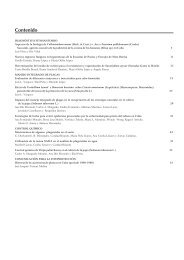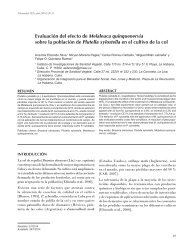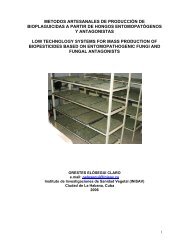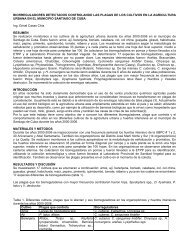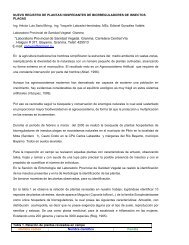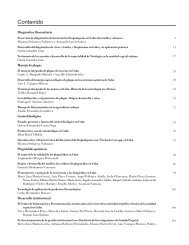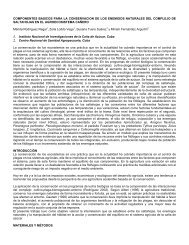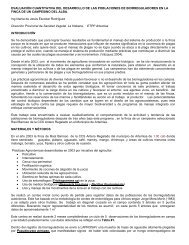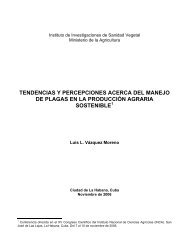Elósegui y otrosaislado para patentar, registrar los productos ymonitorear tanto su <strong>de</strong>stino en el ecosistema don<strong>de</strong> selibere como las posibles interacciones negativas quepuedan existir entre el aislado liberado y el resto <strong>de</strong> losaislados <strong>de</strong> la misma especie [Jenkins y Grzywacz, 2000;Bielikova et al., 2002].Finalmente todos los aislados <strong>de</strong> interés obtenidos seincorporaron al banco <strong>de</strong> cepas <strong>de</strong> hongos entomopatógenos,y en la base <strong>de</strong> datos <strong>de</strong> esa colección se registraronlas características macroculturales, microculturales,origen y especie a que pertenecen, con elobjetivo <strong>de</strong> conservarlos como agentes potenciales <strong>de</strong>biocontrol <strong>de</strong> insectos plaga para futuros estudios.CONCLUSIONES• Se obtuvieron 17 nuevos aislados <strong>de</strong> hongos entomopatógenos<strong>de</strong> los que uno fue <strong>de</strong> Metarhiziumanisopliae, uno <strong>de</strong> Paecilomyces lilacinus y el resto<strong>de</strong> Beauveria bassiana.• El método <strong>de</strong> aislamiento directo a partir <strong>de</strong> insectosmicosados tuvo 42% <strong>de</strong> efectividad.• El método <strong>de</strong> aislamiento a partir <strong>de</strong> muestras <strong>de</strong>suelo <strong>de</strong> hongos entomopatógenos mediante trampeocon larvas <strong>de</strong> Galleria y Corcyra fue muy inefectivo,con 7% <strong>de</strong> éxito solamente.REFERENCIASBarnett, H. L.; B. B. Hunter: Illustrated Genera of Imperfect Fungi, 4 thEdition, The American Phytopahological Society Press, 1998.Bateman, R.; M. Carey; D. Moore; C. Prior: «The Enhanced Infectivity ofMetarhizium flavoviri<strong>de</strong> in Oil Formulations to Desert Locusts at LowHumidities», Annals of Applied Biology 122:145-52, 1993.Bateman, R; M. Carey; D. Batt; C. Prior; Y. Abraham; D. Moore; N. E.Jenkins; J. Fenlon: «Screening for Virulent Isolates of EntomopathogenicFungi Against the Dessert Locust Schistocerca gregaria(Forskal)», Biocontrol Science and Technology 6:549-60, 1996.Bieliková, L.; Z. Landa; L. S. Osborne; V. Èurn: «Characterization andI<strong>de</strong>ntification of Entomopathogenic and Mycoparasitic Fungi UsingRAPD-PCR Technique», Plant Protection Science 38 (1):1-12, 2002.Bridge, P. D.; M. A. J. Williams; C. Prior; R. R. M. Paterson: «Morphological,Biochemical, and Molecular Characteristics of Metarhizium anisopliaeand M. flavoviri<strong>de</strong>», J. Gen. Microbiol.139:1163-1169, 1993.Bridge, P. D.; D. K. Arora: «PCR for Species Definition», Applicatios ofPCR in Mycology, CAB International, Wallingford, 1998, pp. 63-84.Bustillo, A.; M. Bernal; P. Benavi<strong>de</strong>s; B. Chaves: «Dynamics of Beauveriabassiana and Metarhizium anisopliae Infecting Hypothenemushampei (Coleoptera: Scolytidae) Population Emerging from FallenCoffee Berries», Fla. Entomol. 82:491-498, 1999.Carmichael, J. W.; W. B. Kendrick; I. L. Connors; L. Sigler: Genera ofHyphomycetes, Univ. Alberta Press, Edmonton, Canada, 1980.CMI: Descriptions of Pathogenic Fungi and Bacteria. The CambrianNews, Commonwealth Agricultural Bureaux, Surrey, Inglaterra, 1979.Dhoj, Y.; S. Keller; P. Nagel: «Pathogenicity of Entomopathogenic Fungito White Grubs of Maize Based Cropping System in Nepal.Inauguraldissertation zur Erlangung <strong>de</strong>r Wür<strong>de</strong> eines Doktors <strong>de</strong>rPhilosophie vorgelegt <strong>de</strong>r Philosophisch-NaturwissenschaftlichenFakultät <strong>de</strong>r Universität Basel, June 2006, http://www.umad.<strong>de</strong>/infos/cleanair13/pdf/full_348.pdf.Humber, R. A.: «Collection of Entomopathogenic Fungi Cultures, Catalogueof Strains 1992», USDA Agricultural Research Service ARS-110,Plant Portection Research Unit, Ithaca, New York, 1992.Jackson, T. A.; S. B. Alves; R. M. Pereira: «Success in Biological Controlof Soil-Dwelling Insects by Pathogens and Nemato<strong>de</strong>s», BiologicalControl: Measures of Success, Kluwer Aca<strong>de</strong>mic Public Publishers,Boston, EE.UU., 2000, pp. 271-296.Jenkins, N. E.; D. Grzywacz: «Quality Control of Fungal and ViralBiocontrol Agents-Assurance of Product Performance», BiocontrolScience and Technology 10:753-777, 2000.––––: «Towards the Standardization of Quality Control of Fungal andViral Biocontrol Agents», Quality Control and Production of BiologicalControl Agents: Theory and Testing Procedures, CAB International,2003.Johnson, C.; A. H. Bishop: «A Technique for the Effective Enrichmentand Isolation of Bacillus thuringiensis», FEMS MicrobiologyLetters142:173-177, 1996.Lecuona, R.: Microorganismos patógenos empleados en el control <strong>de</strong>insectos plaga, Talleres Gráficos Mariano Mas, Buenos Aires, 1996.López, Miriam: «Paecilomyces lilacinus (Thom) Samson: caracterización,reproducción y obtención <strong>de</strong> un biopreparado con efectonematicida». Tesis en opción al grado científico <strong>de</strong> Doctor en CienciasAgrícolas, INISAV, La Habana, 1995.Moore, D.; R. W. Caudwell: «Formulation of Entomopathogens for theControl of Grasshoppers and Locusts, Memoirs of the EntomologicalSociety of Canada 171:49-67, 1997.Posada, F. F.; M. P. Marín; S. M. Pérez: «Paecilomyces lilacinus, enemigonatural <strong>de</strong> adultos <strong>de</strong> Hypothenemus hampei», Cenicafé (Colombia):49(1):72-77, 1998.Rho<strong>de</strong>s, D. J.; J. D. Smith: «Techniques for Quantifying the Ecologicaland Pathological Characteristics of Entomopathogenic FungalStrains». Proceedings of the Brighton Crop Protection Conference-Pests and Diseases, 351-356, 1992Sun, Jianzhong: «Screening and Characterization of Pathogenic Fungifor Possible Control of Coptotermes formosanus». A DissertationSubmitted to the Graduate Faculty of the Louisiana State Universityand Agricultural and Mechanical College in partial fulfilment of therequirements for the <strong>de</strong>gree of Doctor of Philosophy in The Departmentof Entomology, May, 2002, http://etd.lsu.edu/docs/submitted/etd-0415102-230223/unrestricted/Sun_dis.pdf272/fitosanidad
FITOSANIDAD vol. 10, no. 4, diciembre 2006EcologíaDISPERSIÓN, DISTRIBUCIÓN ACTUAL Y NUEVOSRESERVORIOS DE FRANKLINIELLA SCHULTZEI TRYBOM(THYSANOPTERA: THRIPIDAE) EN CUBASantiago F. Jiménez Jiménez, 1 Liuva Pérez López, 2 Martha Toro, 3 Criseida Granda, 4 Amelia Mateo, 5Héctor Sariol, 6 Elisa Rodríguez, 7 Rodney Pérez, 8 Roquelina Jiménez, 9 Ángel Pérez-Alejo 10 y RansésVázquez 111<strong>Instituto</strong> <strong>de</strong> <strong>Investigaciones</strong> <strong>de</strong> <strong>Sanidad</strong> <strong>Vegetal</strong>. Calle 110 no. 514 e/ 5. a B y 5. a F, Playa, Ciudad<strong>de</strong> La Habana, CP 11600, sjimenez@inisav.cu2Centro Nacional <strong>de</strong> <strong>Sanidad</strong> <strong>Vegetal</strong>. Laboratorio Central <strong>de</strong> Cuarentena <strong>Vegetal</strong>. Ayuntamiento 231e/ San Pedro y Lombillo, Plaza <strong>de</strong> la Revolución, Ciudad <strong>de</strong> La Habana3Laboratorio Provincial <strong>de</strong> <strong>Sanidad</strong> <strong>Vegetal</strong>. Carretera a Santiago <strong>de</strong> Cuba Km 2½, Guantánamo4Laboratorio Provincial <strong>de</strong> <strong>Sanidad</strong> <strong>Vegetal</strong>. Carretera Siboney Km 6, Ternerito Lindo, Santiago <strong>de</strong> Cuba5Laboratorio Provincial <strong>de</strong> <strong>Sanidad</strong> <strong>Vegetal</strong>. Prolongación <strong>de</strong> Carbó 40, Alturas <strong>de</strong> Perera y calleHolguín, Holguín.6Laboratorio Provincial <strong>de</strong> <strong>Sanidad</strong> <strong>Vegetal</strong>. Carretera Central vía Santiago <strong>de</strong> Cuba Km 3½, Bayamo,Granma7Laboratorio Provincial <strong>de</strong> <strong>Sanidad</strong> <strong>Vegetal</strong>. Genaro Rojas 86 e/ Marcelino Diéguez y Antonio Barrera,Las Tunas, CP 75200.8Laboratorio Provincial <strong>de</strong> <strong>Sanidad</strong> <strong>Vegetal</strong>. Ave Finlay Km 2½ e/ Planta <strong>de</strong> Nitrógeno y CircunvalaciónNorte, Camagüey9Laboratorio Provincial <strong>de</strong> <strong>Sanidad</strong> <strong>Vegetal</strong>. Carretera Palmira Km 4, Cienfuegos10Laboratorio Provincial <strong>de</strong> <strong>Sanidad</strong> <strong>Vegetal</strong>. Carretera Maleza Km 2½, Santa Clara, Villa Clara11<strong>Instituto</strong> <strong>de</strong> Meteorología. Apdo. 17032, Habana 17, Ciudad <strong>de</strong> La Habana, CP 11700RESUMENDurante el período 2001-2006 se realizaron muestreos en diferentesprovincias <strong>de</strong> Cuba que permitieron actualizar la situación <strong>de</strong> F.schultzei en relación con el grado <strong>de</strong> dispersión logrado por la especie,así como las plantas que le sirven <strong>de</strong> reservorios y su distribución.Se <strong>de</strong>tectó la presencia <strong>de</strong> esta especie <strong>de</strong> trips en la mayoría<strong>de</strong> las provincias <strong>de</strong>l país, y se reconoció que su mayor distribuciónla alcanza en la región oriental, especialmente en Camagüey, Granma,Holguín, Santiago <strong>de</strong> Cuba y Guantánamo. Las especies botánicassobre los que se <strong>de</strong>tectó F. schultzei alcanzaron la cifra <strong>de</strong> 94, <strong>de</strong> lascuales 84 se informan por primera vez para el país. No obstante, elinsecto se <strong>de</strong>tectó <strong>de</strong> forma mayoritaria solamente sobre 24 especies<strong>de</strong> plantas, básicamente vegetales, hortalizas y ornamentales.El mayor número <strong>de</strong> <strong>de</strong>tecciones correspondió a las rosas <strong>de</strong> diferentescolores, y se realizó también un número consi<strong>de</strong>rable <strong>de</strong> ellassobre quimbombó, abrojo, margaritas japonesas, lirios, espinaca,tomate, claveles, calabaza, carolá, berenjena y habichuelas, lo queapunta a las preferencias <strong>de</strong> F. schultzei. Debido a la posibilidad <strong>de</strong>infectarse con tospovirus, que presentan algunas <strong>de</strong> estas especies<strong>de</strong> plantas, y dada la capacidad vectora <strong>de</strong> estos patógenos –<strong>de</strong>mostradapor este trips en numerosos países, incluidos algunos <strong>de</strong> estehemisferio–, se consi<strong>de</strong>ra que son ellas las que actualmente poseenel mayor peligro potencial <strong>de</strong> resultar afectadas por esas enfermeda<strong>de</strong>svirales.Palabras claves: distribución, Frankliniella schultzei, reservorios,tripsABSTRACTSamplings in different provinces of Cuba were carried out during theperiod 2001-2006 that allowed upgrading the status of F. schultzei inrelation with the dispersion gra<strong>de</strong> achieved by the species, as well asthe plants that serve it as reservoirs and their distribution. The presenceof this trips species was <strong>de</strong>tected in most of the provinces and it wasrecognized that its biggest distribution is reached in the orientalregion, especially in Camagüey, Granma, Holguín, Santiago <strong>de</strong> Cubaand Guantánamo. Botanical species on those F. schultzei was <strong>de</strong>tectedreached the figure of 94 and 84 of them are informed the first time forthe country. Nevertheless, the insect was only <strong>de</strong>tected in a majorityway on 24 species of plants, basically vegetables and ornamentals.The biggest number of <strong>de</strong>tections correspon<strong>de</strong>d to different coloursroses, and a consi<strong>de</strong>rable number of them on quimbombó (lady’sfingers), thistle, Japanese daisies, irises, spinach, tomato, carnations,pumpkin, carolá, eggplant and kidney beans, what points out to thepreferences of F. schultzei. Keeping in mind the possibility to beinfected with tospovirus that present some of these species of plantsand given the vector capacity of these patogens –<strong>de</strong>monstrated bythis thrips in numerous countries, including some of our hemisphere–, itis consi<strong>de</strong>red they possess the biggest danger potential to be affectedby this viral group at the moment.Key words: distribution, Frankliniella schultzei, reservoirs, thripsfitosanidad/273
- Page 1 and 2: ContenidoDiagnóstico fitosanitario
- Page 3 and 4: FITOSANIDAD vol. 10, no. 4, diciemb
- Page 5: Detección de β-exotoxina en cepas
- Page 9: FITOSANIDAD vol. 10, no. 4, diciemb
- Page 12 and 13: Hernández y otrosTabla 2. Fauna de
- Page 15 and 16: Aislamiento, identificación y cara
- Page 17 and 18: Aislamiento, identificación y cara
- Page 19: Aislamiento, identificación y cara
- Page 24 and 25: 276/fitosanidadJiménez y otrosTabl
- Page 26 and 27: Jiménez y otrosDe Ávila, A. C.; L
- Page 28 and 29: Estrada y PiñónTabla 1. Relación
- Page 30 and 31: Estrada y PiñónFigura 2. Análisi
- Page 32 and 33: 284/fitosanidadEstrada y Piñón
- Page 34 and 35: Cabrera y otrosbrera et al., 2002a]
- Page 36 and 37: 288/fitosanidad
- Page 38 and 39: Reinoso y otroslos. Las enfermedade
- Page 40 and 41: Reinoso y otrosantagonista preparad
- Page 42 and 43: Fitosanidad tiene como objetivo div
- Page 44 and 45: García y otrosagitados, aunque má
- Page 46 and 47: García y otrosCONCLUSIONES• La p
- Page 48 and 49: Tejeda Gómezmado por estudios del
- Page 50 and 51: Tejeda Gómeznocido como ribotyping
- Page 52 and 53: Tgxkuvc"FitosanidadKPKUCX""""""""""
- Page 54 and 55: Veitía y otrosEn más del 50% de l
- Page 56 and 57: Vázquez y otrosFigura 1. Corte de
- Page 58: FITOSANIDAD vol. 10, no. 4, diciemb



